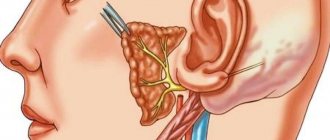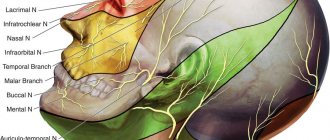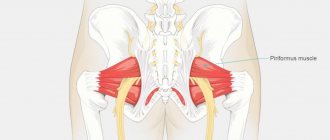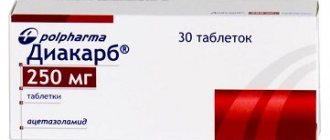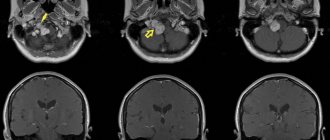The trigeminal nerve is a ganglion that gives rise to three “branches” that exit directly from the brain stem. Three “branches” reach directly to the human face, supplying it with nerves and connecting it with the central nervous system.
The trigeminal nerve exits the skull through three different foramina. The first “branch” comes out through symmetrical points that are located slightly above the person’s eyebrows (the so-called ocular process). The second, emerging, passes along both sides of the nose (just below the eye area and close to the cheeks) and is therefore called the maxillary, the third “branch” exits in the lower jaw (mandibular) in the direction from the corners of the mouth to its center.
With inflammation of various processes of the trigeminal nerve, pain is observed, localized in various places of the face. When the first “branch” is inflamed, pain occurs above or below the brow ridge, in the forehead and in the front part of the temporal region of the head. When the second and third “branches” of the trigeminal nerve become inflamed, pain occurs in the upper and lower jaws, respectively, which, in turn, causes severe toothache.
Next, we will talk about the types of neuralgia, causes and methods of treatment. But if you are experiencing unbearable pain right now, make an appointment with us. When making an appointment, tell the administrator that you need emergency assistance, and they will find an appointment for you as soon as possible. An appointment with a dentist can be made by calling 8 or using the online appointment form.
Types of trigeminal neuralgia
Trigeminal neuralgia is divided into two types. The first, the so-called true trigeminal neuralgia, is a holistic disease caused in most cases by compression of the nerve or disruption of the blood supply. The second type - secondary trigeminal neuralgia - is a symptom of a general disease of the body. It could be a tumor or a serious infection.
In most cases, doctors diagnose inflammation of one of the processes of the trigeminal nerve, but in some situations inflammation of two or three processes occurs at once. Inflammation can affect either one side of the face or both, and in different combinations.
Causes of a cold trigeminal nerve
The causes of a cold trigeminal nerve are often the most ordinary situations in which people find themselves almost every day. Examples include:
- Working air conditioner;
- An open window, both at home and in vehicles;
- Cold wind.
Moreover, in order for an inflammatory process to begin to develop in the body, it is not necessary to be in contact with a flow of cold air for a long time. Sometimes this only takes a few minutes.
In addition, the following factors can also serve as causes of trigeminal neuritis:
- Infectious diseases of a viral and bacterial nature;
- Various types of head injuries;
- The process of intoxication;
- Autoimmune diseases;
- Allergic reactions;
- Poor blood circulation and vascular structure;
- Stressful situations.
The state of the immune system plays a big role in this matter. The risk of catching a cold on the facial nerve with a healthy immune system is much lower than with a weakened one.
Causes of inflammation of the trigeminal nerve
Doctors believe that the main cause of inflammation of the trigeminal nerve is compression of it either inside the skull or outside it. Inside the skull, the trigeminal nerve can be compressed as a result of the formation of tumors, in most cases resulting from some kind of head injury.
Also a fairly common cause of inflammation of the trigeminal nerve is internal venous or arterial displacement.
Other causes of trigeminal neuralgia include:
- the presence of a chronic inflammatory process, viral or bacterial infection in the body;
- herpes infection (herpes);
- a brain tumor;
- scarring in the brain stem;
- failure of anesthesia during treatment or tooth extraction.
Most often, inflammation of the trigeminal nerve affects women at pre-retirement and retirement age (usually from fifty to seventy years). If trigeminal neuralgia is diagnosed in a young man or girl, then most likely its cause is a change in the arteries of a sclerotic nature or a strong dilatation of blood vessels.
Trigeminal neuritis: treatment with modern methods
Today, treatment of the trigeminal nerve consists of the use of medications, physiotherapeutic methods and surgery:
- Drug treatment consists of taking antianginal drugs, which quickly suppress pain, and anticonvulsants, which can block the passage of nerve impulses. Leading Russian clinics use the most modern and effective medications.
- Physiotherapy - the use of ultraphonophoresis, diadynamic therapy, acupuncture have an analgesic effect.
If conservative methods do not bring a positive effect, then surgical treatment of inflammation of the trigeminal nerve of the face is recommended:
- Radiofrequency ablation - “cauterization” of the nerve node, which is located at the site of branching of the nerve fibers, is performed.
- Rhizotomy - this treatment for the trigeminal nerve of the face involves cutting its roots, which blocks the nerve impulse.
- Electrical nerve stimulation - the passage of low amplitude electric current helps to change the activity of the nerve and eliminate pain.
- Microvascular decompression is one of the most effective methods of microsurgical intervention, which allows you to remove compressed nerve fibers of the trigeminal nerve.
- Cyber Knife is an innovative method of treating trigeminal neuralgia. Significant improvement is observed in the vast majority of patients. The essence of the method is targeted irradiation of the pathological focus. The main advantages of the method are painlessness, non-invasiveness, absence of any risks and complications associated with surgery, no need for anesthesia and quick recovery.
How does inflammation of the trigeminal nerve manifest?
The main symptom of inflammation of the trigeminal nerve is severe pain that occurs in the facial part. The pain really has a powerful force and shooting character, so it is very difficult for the patient to calmly endure painful attacks. The pain intensifies when performing the slightest actions with the facial muscles and jaws - yawning, chewing, laughing, and performing daily oral hygiene. At the same time, the sensitivity of the skin on the inflamed side of the face decreases.
The next painful attack is accompanied by a rapid dilation of the patient’s pupils and the same rapid contraction of facial muscles. Increased tear production may begin.
Pain with trigeminal neuralgia is severe, but not constant. The pain occurs for a few seconds and is interrupted for a while. But if the intervals between painful attacks are short, then it seems that the pain is constant. Trigeminal neuralgia is dangerous because the interval between attacks can be several weeks, and sometimes even several months. But after this period, the pain will certainly return. A long break does not mean that the disease has passed, so if you have already noticed symptoms of neuralgia once, you should immediately consult a doctor.
Trigeminal neuralgia: symptoms and consequences
A characteristic symptom of trigeminal neuralgia is an attack of pain, which usually manifests itself in one half of the face and is cyclical. Periods of remission can range from several hours to several months. In atypical or advanced cases of the disease, pain can be almost constant. In this case, the duration of attacks will increase, and the period of remission will decrease.
Typical signs of pain syndrome with trigeminal neuralgia include:
- the nature of the pain in the face is acute, short-term, intense;
- duration of attack - from 10 seconds to 2 minutes;
- the localization of pain and its direction always remain unchanged;
- involuntary spasms of masticatory and facial muscles at the peak of pain.
People suffering from neuralgia use only the healthy half of their mouth when chewing food. The consequence of this is the formation of muscle compactions and loss of sensitivity of the affected half of the face, dystrophic changes in the area of the masticatory muscles.
Why do teeth hurt when the trigeminal nerve is inflamed?
How is inflammation of the trigeminal nerve related to teeth? The connection here is the most direct. Firstly, severe pain during attacks “radiates” to the upper or lower jaw (depending on which nerve extension is inflamed), and sometimes to both jaws. This causes severe and unbearable toothache.
Secondly, those nerves that are found in the upper and lower teeth and gums are directly connected to the trigeminal nerve. The second branch of the trigeminal nerve innervates the upper teeth and gums, and the third, respectively, the lower jaw and gums.
The trigeminal nerve can also be damaged during a number of dental manipulations. Unsuccessful tooth extraction or improper filling, surgical intervention in the jaw structure that ended unsuccessfully, and injuries can cause trigeminal neuralgia.
It is very important to distinguish inflammation of the trigeminal nerve from other diseases of the oral cavity, in particular pulpitis - inflammation of the internal dental tissues. A characteristic sign of inflammation of the trigeminal nerve is that, despite severe pain, the sensitivity of the teeth does not increase when they come into contact with cold and hot foods, and hypothermia or heating does not provoke the onset of a new pain attack. Acute tooth sensitivity is a symptom of pulpitis.
When the trigeminal nerve is damaged in the jaw area, acute toothache, pain in the chin, ears and sometimes in the lower lip occurs. The pain may become increasingly intense, and often the patient continues to feel a dull ache after the attack.
Neuralgia (inflammation) of the trigeminal nerve: signs, symptoms and treatment
Neurologist, City Clinical Hospital No. 10 Kalupina I.G.
Trigeminal neuralgia is compression, irritation, or inflammation of the trigeminal nerve. The disease causes severe pain in the face. More than a million people on the planet suffer from trigeminal neuralgia. The disease most often develops after 40 years. Women are more susceptible to the disease than men.
How does trigeminal neuralgia occur?
The trigeminal nerve is the fifth of twelve pairs of cranial nerves. One trigeminal nerve is located on the left side of the face, and the second is on the right. The trigeminal nerves provide sensation to the eyes, eyelids, forehead, cheeks, nostrils and lips.
Trigeminal neuralgia occurs when the trigeminal nerve is compressed or irritated. Often the disease is preceded by destruction of the nerve sheath. The nerve endings become exposed and react to any impact with an attack of pain. The pain comes on suddenly. It may be preceded by a car accident, dental treatment, or a severe blow to the face.
Causes of trigeminal neuralgia
The following causes of trigeminal neuralgia are distinguished:
- compression of the trigeminal nerve by tortuous vessels or a tumor;
- multiple sclerosis;
- meningitis;
- diseases of the paranasal sinuses;
- malocclusion;
- vascular aneurysms;
- herpes, which affects the trigeminal ganglia;
- hypothermia, injuries, shocks, consequences of concussions;
- viral infection, cold, bacterial infection of the throat and upper respiratory tract.
An attack of trigeminal neuralgia can occur when a person washes his face, shaves, brushes his teeth, talks or smiles. Most often, the disease occurs in older people with metabolic disorders or cardiovascular diseases.
Symptoms of trigeminal neuralgia
The main symptom of the disease is severe excruciating pain in the face. It usually occurs in the upper or lower jaw area. At first a person thinks that he has problems with his teeth. However, after dental treatment the pain does not go away. It intensifies during eating, talking, after hypothermia.
Pain with trigeminal neuralgia can be typical or atypical.
Typical pain is cyclical: it either intensifies or subsides. Shooting pain, similar to an electric shock, begins with touching a certain area of the face. Painful sensations are localized in the lower part of the face, less often around the nose or eyes. Some patients experience pain attacks once a day, others every hour.
Atypical pain is less common and is felt constantly. It involves more of the face than typical pain. With this form of the disease, the pain may not subside. This kind of neuralgia is more difficult to treat.
Other symptoms of inflammation of the facial trigeminal nerve: lacrimation, increased salivation, numbness or increased sensitivity in the lips, eyelids, nose, redness of the facial skin, involuntary contractions of the facial muscles.
Why is inflammation of the trigeminal nerve dangerous?
Without proper treatment, the disease leads to serious complications:
- paresis of facial muscles;
- cerebellar hematoma;
- hearing impairment;
- damage to the nervous system - ataxia.
Due to frequent attacks of pain, a person develops depression, he cannot eat normally, he loses weight, and his immunity weakens. Constant pain can disrupt the psyche, the patient avoids communication.
Treatment of trigeminal neuralgia
Among the methods of treating trigeminal neuralgia, both conservative measures and radical methods are used, in particular, surgery, as well as minimally invasive procedures.
Conservative treatment consists of prescribing various medications and physiotherapeutic methods. Usually, drug treatment is very effective. But, as the disease progresses, drug therapy becomes ineffective or even ceases to relieve attacks of pain. In addition, any drug therapy carries a risk of side effects. In this case, doctors resort to surgical treatment.
Conservative treatment of trigeminal neuralgia
In drug treatment for trigeminal neuralgia, various groups of drugs are used, including:
Anticonvulsants. The most commonly used anticonvulsant is carbamazepine, a very popular and effective remedy for relieving attacks of pain associated with trigeminal neuralgia. In addition to it, other drugs in this group are also used, such as lamotrigine, phenytoin and gabapeptin.
If necessary, when the effect of anticonvulsants decreases, their dose may be increased, or the doctor may prescribe another drug. Therapy with anticonvulsants can also lead to side effects, including dizziness, drowsiness, blurred vision (double vision) and nausea.
Antispasmodics and muscle relaxants. Typically these drugs are used in combination with anticonvulsants. Baclofen is most often used in combination with carbamazepine or phenytoin. They can also be prescribed in isolation.
Alcohol blockades of the trigeminal nerve
Alcohol blockades of the trigeminal nerve lead to the so-called. freezing of the affected area of the face, which is accompanied by a pronounced analgesic effect. This ethanol injection is carried out in the area where one of the branches of the trigeminal nerve passes, which is affected. The effect of such injections is short-lived, and the pain inevitably recurs later, but it is worth noting that even one day without pain is very important for such patients, especially if pain occurs even from rinsing the face. Over time, you have to re-inject.
In addition, there is a risk of complications from such injections in the form of bleeding, a small hematoma if a blood vessel is damaged, and nerve damage. Injection of ethyl alcohol is carried out by intraneural administration in an amount of 1-2 ml. Usually 80% alcohol solution is used in combination with novocaine. In this case, first, 1-2 ml of 2% novocaine is injected, and then, after achieving conduction anesthesia, alcohol is injected. This procedure is most often performed on an outpatient basis, but requires special skill and experience from the doctor in performing such injections.
Surgical treatment of trigeminal neuralgia
During the surgical treatment of trigeminal neuralgia, the doctor tries to eliminate compression of the nerve trunk by a blood vessel. In other cases, the trigeminal nerve itself or its node is destroyed in order to relieve pain. Surgical treatments for trigeminal neuralgia are often minimally invasive. In addition, the surgical method also includes the so-called. Radiosurgery is a bloodless intervention that does not require any incisions or stitches.
Prevention
To prevent the disease, doctors recommend:
- treat teeth, sinusitis, sinusitis, acute infections in a timely manner;
- eat more fresh fruits and vegetables to strengthen the immune system;
- to harden;
- avoid drafts, hypothermia, stress, injuries, intoxication;
- play sports: swimming, dancing, running;
- avoid drafts, hypothermia, stress;
- limit alcohol consumption, do not smoke.
Physiotherapy
Before performing gymnastics, consult your doctor. Do exercises in front of a mirror to control the process. Include the following exercises in your gymnastics:
- Perform smooth head rotations for 2 minutes, first clockwise, then counterclockwise.
- Pull your head and neck first to your right shoulder, then to your left. Repeat the bends 4 times on each shoulder.
- Stretch your lips into a smile, then gather them into a “tube”. Repeat the exercise 6 times.
- Take air into your cheeks and exhale through the narrow gap in your lips. Repeat 4 times.
- Make a “fish”: pull in your cheeks and hold in this position for several seconds. Repeat the exercise 6 times.
- Close your eyes tightly, then open them wide, repeat 6 times.
Treatment of inflammation of the trigeminal nerve
The first stage of treatment for inflammation of the trigeminal nerve is medication. It is aimed at reducing the strength and frequency of pain in the patient. Most often, doctors prescribe anticonvulsants to a patient suffering from trigeminal neuralgia. Sedatives are also used.
Physiotherapeutic procedures, as well as resorption therapy to relieve the inflammatory process, have a good therapeutic effect. Next, the doctor may recommend the use of laser treatment, in which the laser is directed cutaneously to the area where the processes of the trigeminal nerve exit the skull.
Our clinic is located in the same building as the multidisciplinary clinic “Diamed on Shchelkovskaya”, where special conditions for receiving physiotherapeutic procedures are organized for dental patients. The clinic’s physiotherapy room is equipped with modern equipment, including a laser physiotherapy device, with which you will feel relief after the first procedure. The pain will go away and you can return to normal eating. Make an appointment with a dentist by calling 8 or using the online appointment form. The doctor will make an accurate diagnosis and refer you for treatment.
If you are in severe pain, but for some reason you have not yet made an appointment with us, then it can be relieved with folk remedies. Take one tablespoon of yarrow, pour a glass of boiling water, let it brew for one hour and strain. The tincture should be taken one tablespoon before meals three to four times a day.
Trigeminal nerve - what is it?
The trigeminal nerve is located on both sides of the face and is one of the cranial nerves, being one of the largest and most important in terms of functionality. It is responsible for the sensitivity of the skin of the face, teeth, oral mucosa and some other areas of the head, and also partly regulates the process of salivation.
Many people often confuse the trigeminal and facial nerves or even believe that they are one and the same thing. The Internet is full of materials that talk about inflammation of the trigeminal facial nerve or describe the symptoms of inflammation of the trigeminal facial nerve. These formulations are incorrect and mislead people, since these are two different pairs of nerves with their own structural features and functional purpose. The facial nerve is also one of the cranial nerves: it runs quite close to the surface of the face and is also responsible for the work of facial muscles. Neuritis can also affect the facial nerve, but the disease will progress differently.
It is also incorrect to talk about inflammation of the trigeminal nerve of the tooth, since there is no trigeminal nerve in the teeth, but its processes are in close proximity to them.
Symptoms
The main symptom of the disease is severe pain in the facial area. It is paroxysmal in nature and feels like small electric shocks on one side of the face.
Other signs of a cold trigeminal nerve may include:
- Increased tearing and salivation;
- Runny nose;
- Increased irritability, anxiety, sleep disturbance;
- Sensitivity disturbance in some areas of the head;
- High body temperature.
Visible signs on the face are:
- Redness and peeling of the skin;
- Twitching of facial muscles;
- Spasm of the eyelids;
- Facial asymmetry.
The first signs of a cold trigeminal nerve resemble a common cold.
Sensitivity, characterized by pain or numbness, is most pronounced in areas such as the nasolabial triangle, chin and wings of the nose. It is necessary to begin treatment at the first signs of a cold trigeminal nerve.



